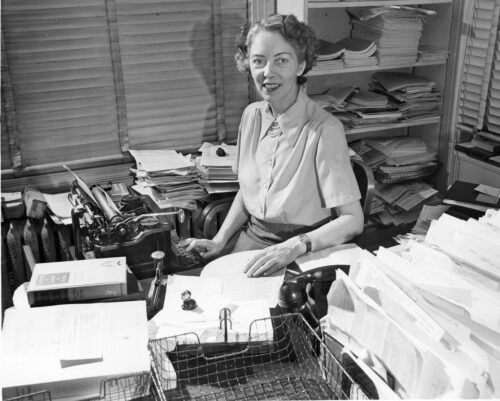Image Courtesy of Smithsonian Institution Archives.
It is late 1937, and the American Society for the Control of Cancer convenes for a press dinner under the dim chandeliers of the Harvard Club. All the invitees are welcome to attend, except one: America’s premier medical journalist, Jane Stafford. To seat a woman at the table would have “considerably changed the character of the dinner,” admitted the organization’s publicity director; besides, the University Club didn’t allow women entry anyway. Thrumming below the frenzied fever of twentieth-century scientific exploration was a culture of leaving women out of a conversation they pioneered, when they were the ones deconstructing scientific jargon.
In her newly released book Writing for Their Lives, historian Marcel Chotkowski LaFollette chronicles the untold story of eight female science journalists who made science intelligible to the average reader and put its latest advances on the front page, but who were themselves omitted from the headlines. These women disseminated scientific discoveries through published stories and columns, breaking both the news and the professional paradigms of the time.
“Historians of science have tended to write about scientists, not those who wrote about science,” LaFollette writes. In her novel, LaFollette attempts to lift the “historical fog” that has hidden the pioneering efforts of these women. In 1921, Science Service, a small Washington, D.C.-based science news organization, gave a group of dedicated female science journalists their footing. Emphasizing meritocracy instead of gender, Science Service boasted a female majority in its cohort of editorial staff writers; Jane Stafford was just one of them.
Jane Stafford’s wide news sweep encompassed everything from schizophrenia to public health epidemics, with a particular focus on cancer. Her work involved expository pieces, like one in 1928 contesting the nicotine-free contents of a tobacco brand. She brought a potent mixture of journalistic strengths to the newsroom: the ability to decipher volumes of dense scientific literature, a dexterity with language (specifically in her allusions to Classical myths and iconography), and an ability to speak truth to power.
In 1945, Science Service reported news of the atomic bomb, explaining the science behind history as it unfolded in real time. While other news outlets succumbed to sensationalism, the female journalists at Science Service collaborated to present a more measured report of the Hiroshima-Nagasaki events. Martha Morrow reported on the physics; Jane Stafford explored radiation and physiology; Helen Davis wrote about its chemistry; and Marjorie Van de Water discussed the bomb’s socio-psychological effects. As “career women,” they braved both the pressures of the news cycle and the inherent misogynies of a male-dominated scientific community.
While occasionally dry in its journalistic tone and factually heavy in its ambitious scope, LaFollette is successful in her detailed account of the hidden figures of scientific journalism. If it took time for science to leave the confines of laboratories and trickle into our lives—learning from curbside newsstands, on the taxi radio, and over morning cups of coffee—Writing for Their Lives shows us that it took far longer to decide who got to tell those stories. “The paths to success [for female journalists] were riddled with the potholes of institutionalized bias along with the gaping gullies of entrenched and unapologetic misogyny,” LaFollette writes. It would be 1973 before the Harvard Club would open its doors to full-time women members. By then, Jane Stafford had already established fundamental journalistic practices, co-founded the National Association of Science Writers, and served as president of the Women’s National Press Club—all while not being allowed to sit in on dinners.

